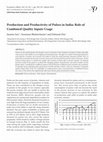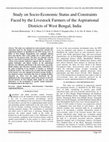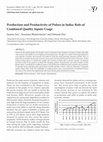Papers by Dr. Sreetama Bhattacharjee

Goat Science - From Keeping to Precision Production [Working Title]
The study was conducted on socio-economic status and constraints faced by the farmers in purposiv... more The study was conducted on socio-economic status and constraints faced by the farmers in purposively selected districts of West Bengal. Respondents were randomly selected from each district with a total sample size of 5000 for the present study. The data was collected with the help of a pre-tested structured interview schedule. The study of various socio-economic indicators suggests that the majority of goat farmers in these districts were illiterate and belong to the lower economic status. It had been observed that women were mostly engaged in goat farming and their financial condition was poor. The education status of these farmers mostly was below 10th standard, and they were mainly engaged in household work. Majority of these farmers had not received any training related to animal husbandry practices and thus provision of suitable training in this area could be helpful for their livelihood security. As the land holding capacity of these farmer were low, goat farming can be an al...
Study on Knowledge Level of the Livestock Farmers of Aspirational Districts of West Bengal, India
International Journal of Livestock Research, 2022

Economic Affairs, 2018
Pulses are the predominant and cheaper source of protein to the majority of people in India espec... more Pulses are the predominant and cheaper source of protein to the majority of people in India especially who are poor and unable to access high priced animal protein. Though our country is the largest producer and importer of pulses, the economy has failed to meet the rising domestic demand recently. Price of pulses has increased enormously in recent years and it has become beyond the reach of the poor. In this context interest grows to explore the supply side of pulses in India after economic reforms. An attempt has been made in this paper to examine the changing pattern of production and yield of pulses across Indian states. Contributions of different states to the production of different types of pulses are examined. Eventually factors affecting pulse production in India and their relative roles are examined. Composite quality Input Index (CII), net availability of under-ground water, and proportion of indebted farmers are some of the factors that significantly affect per hectare p...

The study was conducted on socio-economic status and constraints faced by the farmers in purposiv... more The study was conducted on socio-economic status and constraints faced by the farmers in purposively selected five aspirational districts (as identified by the NITI Aayog, Govt. of India) of West Bengal. Respondents were randomly selected from each district with a total sample size of 4285 number of farmers for the present study. The data was collected with the help of a pre-tested structured interview schedule. The study of various socio-economic indicators suggests that the majority of animal husbandry and fishery farmers in the aspirational districts were illiterate and belong to the most active age group, Hindu religion, and with lower economic status. Cultivation was the main occupation of the majority of farmers to maintain livelihood security. The analysis also revealed that the majority of the farmers were also engaged in livestock rearing. Finally, it also depicted various constraints like lack of training facilities, education etc. These were the major drawbacks for the up...

New Delhi Publishers, 2018
Pulses are the predominant and cheaper source of protein to the majority of people in India espec... more Pulses are the predominant and cheaper source of protein to the majority of people in India especially who are poor and unable to access high priced animal protein. Though our country is the largest producer and importer of pulses, the economy has failed to meet the rising domestic demand recently. Price of pulses has increased enormously in recent years and it has become beyond the reach of the poor. In this context interest grows to explore the supply side of pulses in India after economic reforms. An attempt has been made in this paper to examine the changing pattern of production and yield of pulses across Indian states. Contributions of different states to the production of different types of pulses are examined. Eventually factors affecting pulse production in India and their relative roles are examined. Composite quality Input Index (CII), net availability of under-ground water, and proportion of indebted farmers are some of the factors that significantly affect per hectare pulse production in India.










Uploads
Papers by Dr. Sreetama Bhattacharjee